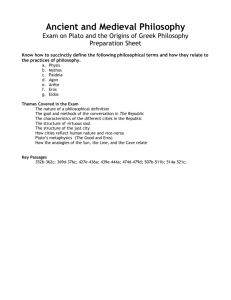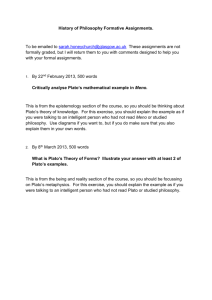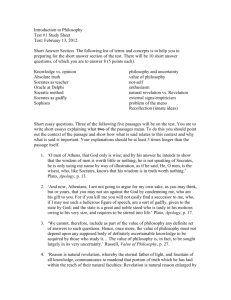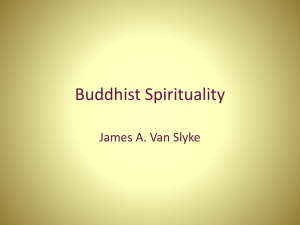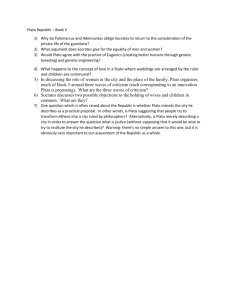How Buddhism and Socratic-Platonic Philosophy Aspire to
advertisement
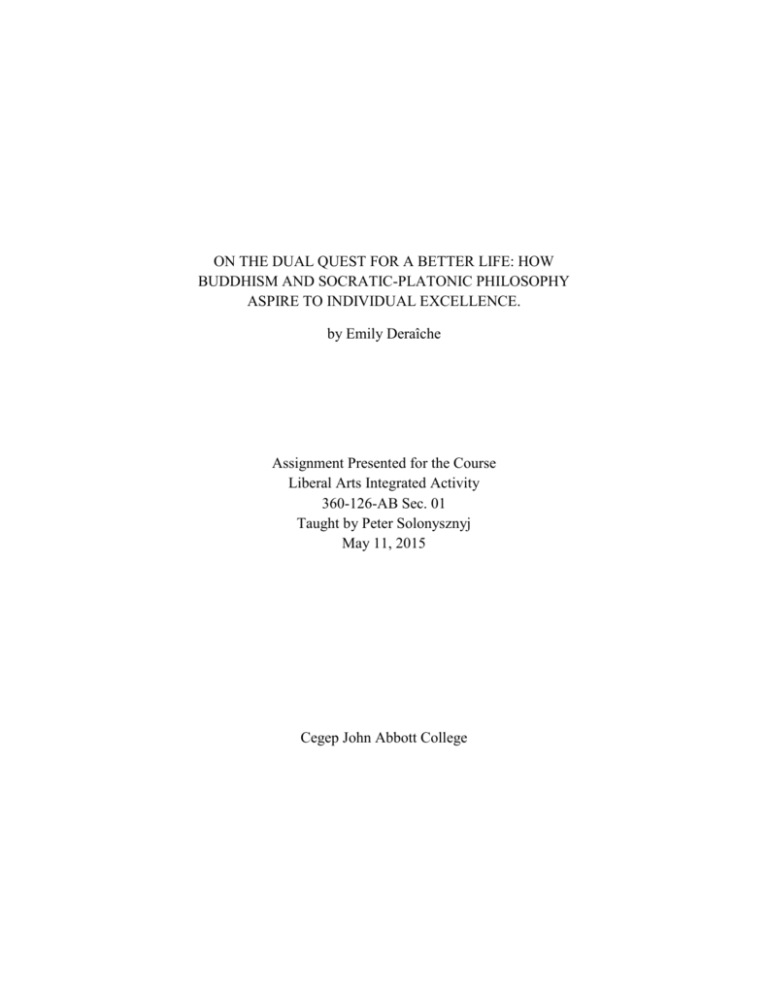
ON THE DUAL QUEST FOR A BETTER LIFE: HOW BUDDHISM AND SOCRATIC-PLATONIC PHILOSOPHY ASPIRE TO INDIVIDUAL EXCELLENCE. by Emily Deraîche Assignment Presented for the Course Liberal Arts Integrated Activity 360-126-AB Sec. 01 Taught by Peter Solonysznyj May 11, 2015 Cegep John Abbott College 1 In Southern Nepal in the fifth century B.C.E., Siddhartha Gautama, the son of a tribal chieftain, left the comforts of his noble birth to discover the source of the suffering that marks existence. Through vigorous meditation, he became the Buddha (‘the awakened one’) and attracted a spiritual community of followers with whom he shared his insight on escaping this suffering, induced by our attachment to the transient elements of life. 1 Within the same century, an Athenian philosopher known as Plato wrote a collection of philosophical dialogues exploring the nature of humanity and morality.2 Inspired by his colleague and philosophical teacher, Socrates, he questioned the values of his society and sought to define the life worth living. Both systems inaugurated by the Buddha and Plato, respectively Buddhism and Socratic-Platonic philosophy, aspire to direct individuals to meaningful lives and continue to influence our world. In essence, Buddhism and Socratic-Platonic philosophy present similar programs for individual excellence, where each system aims to show individuals how to evaluate the basic assumptions by which they live. In each system, the goal is for the individual to reject false or unhealthy assumptions (derived from sources outside the individual) in order to awaken to their innate capacities to create wellness in themselves and in their communities. Both systems build their programs of individual excellence by establishing similar conceptions of the cosmos and innate human capacities. These systems also promote individual excellence by perpetuating teachings and practices for developing self-knowledge, for accessing truth and for fostering positive communities. Furthermore, these systems continue to promote individual excellence as their tenets and practices stay relevant in facing the issues of current society. 1 Peter Heehs, ed., Indian Religions: A Historical Reader of Spiritual Expression and Experience (New York: New York University Press, 2002), 104. 2 Rebecca Goldstein, Plato at the Googleplex: Why Philosophy Won’t Go Away (New York: Pantheon Books, 2014), 17. 2 The references used to support these claims include some original texts relating to Buddhism, as well as Socratic-Platonic philosophy. For Buddhism, this includes excerpts from translations of various traditional Buddhist texts, and for Socratic-Platonic philosophy, this includes excerpts from translations of some of Plato’s dialogues. References will also include expertise in the respective fields of both Buddhism and Socratic-Platonic philosophy. The examination of Buddhism’s program for individual excellence certainly calls upon the discipline of religion. First off, religion represents an expression of collective human experience, where there is a shared practice of rites and shared knowledge of beliefs within a spiritual community; however, the individual experience of religion is also a fundamental.3 In the Western world, Buddhism’s status as a religion is attenuated once labeled “philosophy” or “New Age Spirituality” by Western thinkers; however, in its founding countries of South Asia, it is certainly a religion, manifesting itself in daily rituals.4 There are many schools of Buddhism, which fall under one of the two main branches; Theravada and Mahayana. 5 This text will reference the key concepts and practices universal to all facets of Buddhism, and may include examples from either the Theravada or Mahayana traditions. For Socratic-Platonic philosophy, expertise will include the work of scholars specializing in Socrates, in Plato and in philosophy in general. This system is named “Socratic-Platonic philosophy” in this text because though Plato developed his own ideas and was the author of the dialogues, the texts which passed down knowledge of Socrates and his philosophy, Socrates is without doubt “central to Plato’s conception of philosophy.” 6 Socrates and Plato therefore represent a sort of continuum of philosophical thought, and so elements of the philosophies of 3 Heehs, 5. Laurent Testot, “Qu’est-ce que le bouddhisme?,” Sciences Humaines, August 2011, 18. 5 Ibid., 23. 6 Goldstein, 10. 4 3 both are referenced as examples. Of course, with this system the discipline of philosophy becomes part of this text. Finally, while Plato at the Googleplex, by Rebecca Goldstein, plays an important role as a source of information for the Socratic-Platonic system, it also connects to the project of this text on a larger scale. In effect, Plato at the Googleplex connects to the whole of this project with two distinct concepts. First, Goldstein’s discussion of the “Axial Age” connects to two of the main implications of this project: that within the same time period, yet within distinct cultures and continents, two systems of conceiving the life worth living were born, and that the ideas set forth by both systems reverberate within current society. Goldstein essentially explains that the philosopher Karl Jaspers named the period of 800 to 200 B.C.E., where multiple cultures developed various approaches to the question of meaningful living, the “Axial Age” as the ideas forged by these approaches “extend out into our own day, like the axials of a wheel.” 7 Just like the “Axial Age,” this project highlights the conjunction of conceptions of human excellence that occurs between Buddhism and Platonic-Socratic philosophy, which stem from diverging cultures and separate disciplines, yet which nevertheless pull at the same threads of questioning assumptions and appearances as a means of becoming a better person. This project also demonstrates how the notions commonly developed by Buddhism and Socratic-Platonic philosophy, such as moving beyond appearance to find truth and detaching from false views of the self, have made it into our own society and continue to be relevant. Second, Goldstein’s elaboration of the Socratic-Platonic notion of areté (virtue) as a challenge to the Athenian society’s concept of areté connects to how both Buddhism and Socratic-Platonic philosophy teach the rejection of virtue derived from external factors. In essence, Goldstein explains that the 7 Ibid., 7. 4 ancient Greeks held the Ethos of the Extraordinary, where they believed that to have a meaningful life was to stand out somehow. More specifically, they believed that to lead a meaningful life was to lead “a life worth the telling, a thing that will have an impact on other minds.” 8 Socrates and Plato still maintained an Ethos of the Extraordinary, but based it on the internal source of virtue, where virtue relates to the morality of the individual. Similarly, Buddhism rejects any identification of the self derived from external experiences or feelings. In both cases, external definitions of virtue are irrelevant to the individual, and this tenet becomes central to the prescription to individual excellence for each. To begin, Buddhism and Socratic-Platonic philosophy assert similar truths about innate human capacities and drives. These truths become the principles on which the practice of each system will be based; therefore, individuals must be turned towards these truths about themselves if they are to proceed in either system. For one, both establish that human beings naturally tend towards goodness. In Buddhist psychology, this is expressed through the concept of the “Buddha nature” that exists in each individual. This concept indicates that in each person, there is a Buddha waiting to be rediscovered; this means that the individual is inherently noble, beautiful and “awakened.” 9 Similarly, in his dialogue Symposium, Plato makes the argument that the individual naturally tends toward goodness. In essence he states that like a lover, the individual naturally yearns for what it lacks, such as beauty and the good; this yearning will drive the lover towards goodness. 10 These instances demonstrate that both Buddhism and Socratic-Platonic philosophy establish the individual’s innate capacity for goodness so that during their practice of self-knowledge, they will be able to identify and eliminate any false assumptions of innate 8 Ibid., 129. Jack Kornfield, The Wise Heart: A Guide to the Universal Teachings of Buddhist Psychology (New York: Bantam, 2009), 12. 10 Norman Melchert, The Great Conversation: Volume I (Oxford: Oxford University Press, 2014), 139. 9 5 wickedness or brokenness. Such assumptions of the inherently negative nature of human beings could hinder the individual’s progression towards the excellent self; it is difficult to ascend towards the divine if one feels unable to equate with its qualities. Second, both systems confirm that individuals contain innate knowledge and innate capacity to wisdom. For instance, Buddhism assigns an all-knowing feature to human consciousness. It defines consciousness as being “clear, open, awake, without colour or form, containing all things, yet not limited by them.” 11 In essence, as each individual possesses consciousness, each individual possesses the capacity to hold all-encompassing awareness that sees everything, but does not get distracted by any one thing. Socrates and Plato also establish that individuals have inherent wisdom. Socrates asserts that soul knows truth before it enters the human body. Therefore, all learning becomes relearning the truth we knew before birth (like the rediscovery of the all-knowing power of our consciousness). 12 For both Buddhism and Socratic-Platonic philosophy, reminding individuals of their innate wisdom will become essential as they embark on the practice of questioning assumptions and contemplating the self. The reminder is not only there to convince individuals that they have what it takes to embark on such a rigorous intellectual, psychological and spiritual journey, but that it is their natural duty to do so. Finally, both Buddhism and Socratic-Platonic philosophy indicate that individuals have an essence that is unchanging, timeless and formless. As already mentioned, in Buddhism this essence is consciousness. On the other hand, in his dialogue Phaedrus, Plato indicates that “a body deriving its motion from a source within itself is animate or besouled” and that “all soul is immortal.”13 Essentially, this means that entities that can move themselves, like human beings, contain an inherent, self-sustaining source of energy and life; this self-sustaining essence is the soul, and it is immortal. Establishing the intransient, 11 Kornfield, The Wise Heart: A Guide to the Universal Teachings of Buddhist Psychology, 38. Melchert, 68. 13 Ibid., 142. 12 6 immortal essence of human beings, both systems set-up their separation from things that do change, and which therefore merit less attention and attachment. The unchanging nature of humans’ essence also connects them to the intransient elements of the cosmos. Next, Buddhism and Socratic-Platonic philosophy assert similar truths regarding the composition of the cosmos. Both develop conceptions of the world that divide it between things that are changing, conditioned and decaying, and things that are timeless, pure and stable. We have already seen how both systems have established the presence of unchanging and stable things in individuals (wisdom, timeless essence, goodness). In pointing out the things in the world that are opposite to these intransient objects, as well as how to discern between the two, both systems once again prepare individuals for further practice; learning to discern between conditioned and unconditioned objects will guide individuals in knowing what objects to turn their attention to for optimal well-being. Buddhism’s conception of the cosmos in this fashion is expressed in the law of Dharma. This idea is best expressed in these lines from The Lotus Sutra, one of the more famous Buddhist texts (a sutra is a Buddhist sermon): If you wish to win omniscience, then you should aspire to superknowledge, and then reflect, in the forest, on the emission of the pure darhma, by which you will gain the superknowledges...all dharmas are the same, essentially, without multiplicity.14 As these lines illustrate, Dharma acts as the law unifying all truth; all the multiplicity of the world, which is simply delusion created by our senses, is actually non-existent and can be reduced to Dharma. This quote also hints at how one is to encounter Dharma; by reflecting “on the emission of the pure darhma.” So, unlike the multiplicity interpreted by our senses, Dharma 14 Heehs, 179. 7 can only be accessed through concentrated awareness. We are also provided with the information that the Dharma can bring us “superknowledges,” or some kind of heightened wisdom. The law of Dharma and the distinction made between the one versus the multiplicity mirrors Plato’s conception of the cosmos, where he divides the world into the World of Opinions and the World of the Forms. The World of Opinions includes things and the likeness of things (that is, their shadows), and is intelligible through the senses (it is the world we observe around us); essentially, it equates with the multiplicity spoken of in The Lotus Sutra. This world is also characterized as delusional, as it distracts from the more real expressions of things, which lie in the World of the Forms.15 As the World of Opinions is made discernible only through the senses, all that can be generated from this world is opinion, which Plato classifies as changeable and falsifiable.16 The World of Forms, on the other hand, contains the forms, or true models, of all the things discerned in the visible world. This world is intelligible through knowledge, which is contrasted with opinion as it endures and is necessarily true. This world includes lower forms (including forms of furniture or of physical descriptions) and higher forms (including forms of virtues and morals). The highest form, the form from which all other forms and things derive, is the Form of the Good, according to Plato.17 The Form of the Good can be equated with the law of Dharma, and like the Dharma, the Form of the Good is intelligible only through a higher knowledge. The conclusion to be drawn from the examples of the Dharma versus the multiplicity and of the Form of the Good versus the multiple things in the World of Opinions is that both Buddhism and the Socratic-Platonic system are trying to draw clear distinctions of the items of intelligibility that are more true, and those which are less so; in both examples, the highest truth 15 Melchert, 128-130. Ibid., 121. 17 Ibid., 131. 16 8 is accorded to the One unchanging source of all, and this one is made to be the most valuable object of knowledge. Knowledge of this One requires more than sensory experience and an elevated wisdom. Through their conceptions of the cosmos, both Buddhism and the SocraticPlatonic system define the objects towards which individuals should raise their consciousness in the practices laid out by each system: the unchanging, true objects that connect everything. Understanding the Buddhist and the Socratic-Platonic conceptions of the cosmos begs an explanation of each system’s concept of the Divine. The two systems diverge in this regard, both in their conception of the form of the Divine, as well as in their conception of the individual’s relationship with the Divine. In the text Teachings of Huang Po, we learn that Buddhism envisions the divine as “The Void” that is “fundamentally without spacial dimensions, passions, activities, delusions or right understanding” and that is “all-pervading, spotless beauty.” 18 In essence, the Buddhist Divine is an unlimited, unqualified essence that is everywhere and in everything at once. In Socratic-Platonic philosophy, Socrates envisions the Divine as a god and as the only being who truly knows the forms of goodness, beauty and justice.19 Regarding the individual’s connection with the Divine, Buddhism teaches that because the Divine permeates everything, the individual can certainly experience it; it is in pursuing the Dharma and in eliminating “all conceptual thought” (accomplished during meditation) that it can be accessed. 20 On the other hand, in Socratic-Platonic philosophy, Socrates expresses that human beings cannot know the Divine because their intellect cannot apprehend it; he does believe, however, that in pursuing the of Form of Good, the individual can come very close to the god. 21 In Buddhism, then, the Divine is more accessible to the individual than it is in Socratic-Platonic thought; where 18 Kornfield, Teachings of the Buddha (Boston: Shambhala, 2012), 194. Melchert, 100. 20 Kornfield, Teachings of the Buddha, 195. 21 Melchert, 100. 19 9 Buddhism encourages the individual’s contact with the Divine by establishing its easy accessibility through the individual’s own mind, the Socratic-Platonic system distances the individual from the Divine by establishing the individual’s inaccessibility of it. Though Buddhism and Socratic-Platonic philosophy differ slightly in their conception of the Divine, they still recommend similar practices for individual excellence. Following their declarations of human nature and nature of the cosmos, both Buddhism and Socratic-Platonic philosophy prescribe practices for self-knowledge that reflect these declarations. In effect both systems recognize the need for individuals to have immediate contact with the knowledge that has been asserted about themselves and the world in order to understand it and live accordingly. For one, Buddhism prescribes the practice of meditation as a way for the individual to come into contact with the true essence of the self, which has already been established as enduring consciousness. During meditation, individuals become aware of their consciousness through a process called “mindfulness”. Mindfulness involves consciousness quietly observing any sensations that pass over the body or thought and feelings that pass through the mind without judgement of them and without being affected by them. 22 This is embodied well in the following excerpt from a traditional Buddhist text on the Four Foundations of Mindfulness: “...a bhikku [Buddhist monk] abides contemplating the body as a body, ardent, fully aware, and mindful, having put away covetousness and grief for the world."23 In other words, mindfulness is a process of objective observation of the body, feelings and mind that conduces the realization that the true self is not related to any of these things. Therefore, the self cannot be defined as any of these things that occur externally to the true self (consciousness) and which are transient (as opposed to the enduring of the consciousness). The previously established 22 23 Heehs, 124. Ibid., 125. 10 separation of true objects from delusions in the cosmos relates to the separation of delusions of the self from true consciousness. This separation of delusion selves from the true self represents an example of rejection of faulty assumptions (that your feelings, thought and body define you). Furthermore, the pre-established truth of the immortality and inherent wisdom and goodness of consciousness makes it possible to recognize the innate wonder of consciousness. This recognition of the inherent good of consciousness represents the subsequent awakening of the individual to his or her inner capacities for goodness. The Socratic-Platonic prescription for self-knowledge does not take the form of a psychosomatic process like meditation; however, it is nonetheless spiritual. The SocraticPlatonic process of accurate self-knowledge relates specifically to the Socratic-Platonic definition of areté, or virtue, where “the autonomous moral life of the wise man, which cannot be governed by any set of rules imposed from without” becomes the focal point.24 As Goldstein writes in Plato at the Googleplex, by introducing this new definition of human excellence and by claiming that “the unexamined life is not worth living,” Socrates revised the Greek Ethos of the Extraordinary, where “ “Unexamined” is substituted for “unexceptional.” ” 25 By doing so, Socrates ignited an intellectual process of discerning the truth of the self from the delusion of the self, mirroring the aims of Buddhism’s meditation. However, instead of meditating, he suggests the rejection of kleos (recognition of others) and of social arête. He shows how to turn away from the delusions of external validation (they are ever-changing, and certainly of the unstable world of opinions). However, like meditation, Socrates’ process directs the individual to contemplate the true, enduring part of the self; the soul (or consciousness, in Buddhism). Socrates urges the individual to care for his or her soul, which is to be done through persistent 24 25 Reginald E. Allen, ed., Greek Philosophy Thales to Aristotle (New York: The Free Press, 1991), 18. Goldstein, 126. 11 examination of one’s beliefs, also known as the search for the truth.26 The objective examination of one’s beliefs parallels the impersonal observation of body, feelings and thoughts produced through mindfulness. Furthermore, both Buddhism and Socratic-Platonic philosophy prescribe practices for knowledge of truth in general that reflect their declarations about human nature and nature of the cosmos. Essentially, both systems seek to equip individuals with tools they can use to avoid delusion and recognise truth in matters outside themselves. Buddhism essentially prescribes the same practice for gaining truer general knowledge as for gaining self-knowledge: meditation and mindfulness. However, it would be useful to understand the ultimate goal that Buddhism seeks for the individual who pursues mindfulness to its utmost degree: Nirvana. Nirvana is the state reached once the individual has abandoned all desire and attachment to transient, delusional objects, and who is thus said to have achieved the end of suffering and the end of the cycle of rebirth.27 This escape of changes and recurring birth can be also be seen as the permanent connection with the Dharma, the whole being that encompasses all and that is everlasting. In the Socratic-Platonic philosophy, however, the prescribed practice is the dialectic, the purely intellectual pursuit for the “ultimate presuppositions of all our hypothetical explanations.”28 The goal here is for the individual to come into contact with the Form of the Good, as it the most ultimate of all presuppositions, encompassing everything, as we have seen. Plato described ascension to the Form of the Good as “a wondrous vision” and “everlasting loveliness.”29 In both these cases, both systems are once again trying to orient the individual towards enduring objects 26 Melchert, 68. Testot, 21. 28 Melchert, 130. 29 Ibid., 140. 27 12 of knowledge that provide ultimate truth and which provide relief from the suffering induced by faulty assumptions. Both Buddhism and Socratic-Platonic philosophy also involve service to others as part of their program for the excellence of the individual. This reflects both the Buddhist and SocraticPlatonic belief in the interconnectivity of all things, reflected in the all-encompassing nature of the Dharma and of the Form of the Good, respectively. In essence, in both systems, it is not enough to work towards the enlightenment of your own soul, but you must also work towards the enlightenment of all others. In Buddhism, this is best embodied in the bodhisattva. In Sanskrit, this means, “being who is devoted to awakening and to acting for the benefit of all that lives.” 30 Essentially, though self-absorption and isolation may be necessary for some time to develop profound understanding of the self, this must always be done with the intention of bringing wellbeing to others and to the world on the whole. Besides, “our highest happiness is connected with the well-being of others,” according to Buddhist psychologist Jack Kornfield.31 The SocraticPlatonic system echoes this sense of interconnectivity between beings through Socrates’ assertion that by acting unjustly towards another, one is just harming oneself.32 The bodhisattva is echoed in Plato’s philosopher kings who, having knowledge of the forms, particularly of the Forms of Justice and Morality, would be expected to wisely guide and look-over the community in Plato’s ideal state.33 These examples show that for both Buddhism and Socratic-Platonic philosophy, the individual does not come full circle in terms of personal excellence unless they use the practice of denying delusion and accessing inner truth for the betterment of the community at large. 30 Kornfield, The Wise Heart: A Guide to the Universal Teachings of Buddhist Psychology, 354. Ibid. 32 Melchert, 102. 33 Ibid., 150. 31 13 Though both Buddhism and Socratic-Platonic philosophy similarly describe how the individual must improve the community, it is in regards their conception of the ideal community that they differ perhaps the most. In essence, in his dialogue Republic, Plato elaborates a structure for the ideal state that is founded on the belief that only a few have the potential to attain the wisdom that results from the practice of the dialectical method. He asserts that it is these enlightened few who would be allowed to govern the state, as they would be the ones who would have knowledge of the Form of the Good. Their knowledge would enable them to make wise decisions and would prevent their corruption.34 Then, to assure that the large majority of citizens, incapable of knowledge of the Form of the Good, would have correct opinions, Plato suggests that they be “firmly persuaded that it pays to be moral.”35 Here, Plato’s assertion that different individuals have varying potential for enlightenment opposes the Buddhist tenet that every human being has a “Buddha nature” within and can therefore achieve spiritual awakening. This Buddhist tenet is expressed when Jack Kornfield explains that Buddhist teachings “are an invitation to all who hear them to discover their own Buddha-nature, the freedom and great heart of compassion that is possible for every human being.”36 Though Buddhism’s vision of the human potential for enlightenment promotes a more egalitarian relationship between individuals when compared to the Socratic-Platonic system, Buddhism’s lack of a structured organization for society mirroring that of Plato’s ideal state may put Buddhism’s vision for a healthy society at somewhat of a disadvantage in terms of the feasibility. This ambiguity of vision for society can be seen in the Buddhist text, Advice for Sustaining the Community: As long as the followers of the way hold regular and frequent assemblies, they may expected to prosper and not decline. As long as they meet in harmony, break-up in 34 Ibid. Ibid., 151. 36 Kornfield, Teachings of the Buddha, xv. 35 14 harmony, and carry out their business in harmony, they may be expected to prosper and not decline.37 In essence, though this passage conveys that key Buddhist concepts, such as harmony, are essential in establishing a successful community, it is left unclear exactly how these concepts can be applied systematically to organize a functioning society. However, though traditional Buddhist text may unclearly define how Buddhist tenets may be used in establishing a healthier society, contemporary experts in Buddhism tend to describe how Buddhism can apply to the community in a more concrete manner. Lastly, we can achieve a final assessment of how Buddhism and Socratic-Platonic philosophy aim at personal and communal well-being by looking at how experts in each system defend the relevance of the system to contemporary times. In The Wise Heart, Jack Kornfield explains that in developing the Buddhist inquiry of consciousness and practice of settling into the objective knowing of consciousness, we can train ourselves to face all circumstances, even the most confusing and trying, with the same poised observation. 38 In Coming to our Senses, Jon Kabat-Zinn argues that in using the Buddhist principles of detached, non-judgemental observation and not-knowing, we can prevent ourselves from forming harmful delusional notions about global conflict, and therefore heal the body politic. 39 On the other hand, in Plato, Ieuan Williams argues that we could use Plato’s myth of the Cave to question the modern caves (creators of delusional imagery) that dominate our society, like our media.40 He also argues that in the face of our modern ethos of capitalism, where we tend to define human beings according to materialistic terms, Plato’s questioning on moral issues could be of much avail.41 Finally, in 37 Ibid., 113. Kornfield, The Wise Heart: A Guide to the Universal Teachings of Buddhist Psychology, 45. 39 Kabat-Zinn, 503. 40 Williams, 118. 41 Ibid., 107. 38 15 Plato at the Googleplex, Rebecca Goldstein argues that we still need Plato’s philosophy, and philosophy as whole because there will always be questions of morality and of human nature that science cannot cover and that can only be broached by philosophy (like the issue of accountability).42 Goldstein argues that we need Socratic-Platonic philosophy that questions society’s basic assumptions for progress.43 As we have seen, Buddhism, a religion, and the Socratic-Platonic method, a philosophy, both prescribe a program of individual excellence that make individuals cognizant of their ignorance that derives from faulty assumptions, that guide the individuals to awaken to the true nature of themselves and the world they inhabit to obtain truth, and that then instruct individuals to use their new found truth for the betterment of society. Though they respectively build their programs of individual excellence on conceptions of the cosmos that reduce the multiplicity of objects humans observe through the senses to one unifying source, as well as on the belief that humans have an innate capacity for wisdom and goodness, they diverge slightly in their conceptions of the Divine and of the development of successful community. This means that for the last 2, 500 years, an Eastern religion and a Western philosophy have been grappling at a similar wisdom and have been vying for the spread of that wisdom as a means to happier, healthier individuals and a better society. Yet, there is still plenty of room for such influence in our society, which may need these systems of wisdom now more than ever as we neglect to inquire into the nature and needs of our humanity. 42 43 Goldstein, 421. Ibid., 9.
